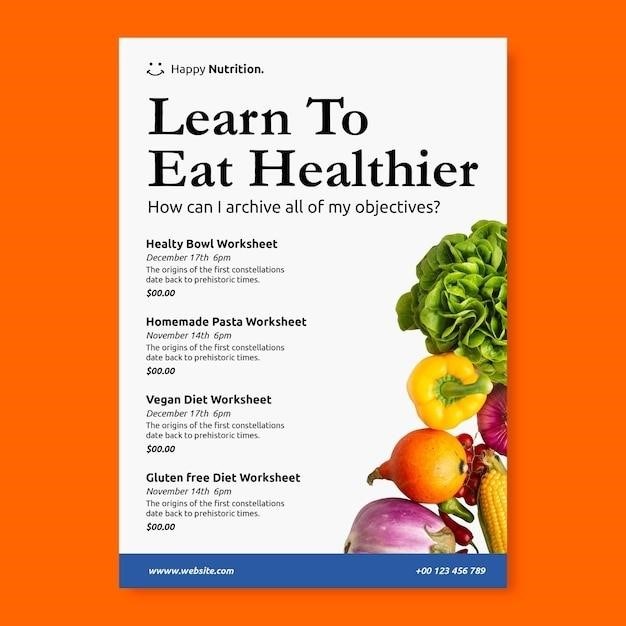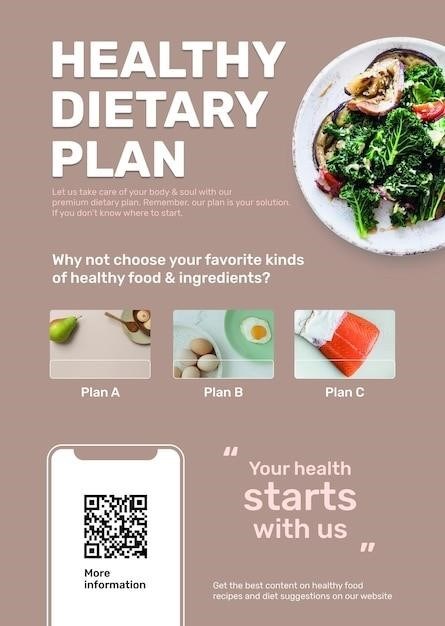
low residue diet menu pdf
Understanding the Low Residue Diet
A low-residue diet minimizes fiber intake, reducing bowel movements’ frequency and volume. This aids in healing after bowel surgery or before procedures. It’s crucial for managing digestive issues and promoting gut health. Careful meal planning is essential for nutritional balance.
What is a Low Residue Diet?
A low-residue diet, also known as a low-fiber diet, significantly restricts the amount of fiber in your daily food intake. Fiber, while beneficial for most, can be irritating to the digestive tract, especially following bowel surgery, during periods of gastrointestinal distress, or in preparation for colonoscopies. This diet aims to reduce the bulk and frequency of bowel movements, thereby minimizing irritation and promoting healing. It involves consuming foods that are easily digested and leave minimal undigested material in the intestines. This approach focuses on minimizing strain on the digestive system, allowing for a more comfortable and efficient recovery process. The diet’s success depends on meticulously selecting foods that are low in fiber and easy to digest.
Purpose and Benefits of a Low Residue Diet
The primary purpose of a low-residue diet is to reduce the workload on the digestive system. This is particularly beneficial in situations where the intestines are inflamed, recovering from surgery, or preparing for a medical procedure like a colonoscopy. By limiting fiber intake, bowel movements become less frequent and less bulky, minimizing irritation and discomfort. This gentle approach allows the digestive tract to rest and heal. Benefits include reduced abdominal cramping, decreased diarrhea frequency, and improved consistency of bowel movements. The diet assists in managing symptoms associated with inflammatory bowel diseases like Crohn’s disease and ulcerative colitis. While not a weight-loss diet, it facilitates recovery from gastrointestinal issues, improving overall comfort and well-being during the healing process. Individualized plans, potentially with a registered dietitian, ensure adequate nutrition.
Foods to Include in a Low Residue Diet
A low-residue diet emphasizes easily digestible foods low in fiber. Excellent protein sources include lean meats like chicken and fish, eggs, and tofu. Refined grains such as white bread, white rice, and refined cereals are preferred over whole grains. Well-cooked vegetables, peeled to remove skins and seeds, are suitable options. These include carrots, potatoes (without skin), and asparagus. Strained fruits like applesauce or well-cooked, peeled fruits are acceptable in moderation. Dairy products like yogurt (plain, low-fat) and milk are generally well-tolerated. Low-fat or fat-free options are recommended to minimize digestive stress. Soups made with refined ingredients are also suitable. Remember to limit fats and oils to manageable quantities. Always check with your doctor or registered dietitian for personalized recommendations.

Sample Low Residue Diet Meal Plans
This section provides example meal plans to guide you. These plans offer balanced nutrition while adhering to low-residue principles. Remember, individual needs vary; consult a professional for personalized guidance.
7-Day Mediterranean Low Residue Diet Plan
This 7-day Mediterranean low-residue diet plan offers a delicious and manageable approach to dietary restrictions. Each day features a variety of easily digestible foods, emphasizing lean proteins, refined grains, and low-fiber vegetables. The plan incorporates the flavors and principles of Mediterranean cuisine, making healthy eating enjoyable even with limitations. Breakfasts might include options like scrambled eggs with spinach (ensure spinach is thoroughly cooked to reduce fiber content), whole-wheat toast (though consider white bread for a lower residue option), or plain yogurt with a small amount of honey. Lunch could consist of grilled chicken salad with romaine lettuce and a light vinaigrette, or a tuna salad sandwich on white bread. Dinner might feature baked cod with steamed carrots and white rice, or chicken breast with mashed potatoes. Snacks could include plain rice cakes, low-fiber fruits like bananas (in moderation), or a small portion of cooked and peeled applesauce. Remember to stay hydrated by drinking plenty of water throughout the day. This plan prioritizes nutrient intake while minimizing fiber to aid digestion. Always consult a healthcare professional or registered dietitian before starting any new diet, especially if you have underlying health conditions.
Sample One-Day Low Residue Diet Menu
This sample one-day low-residue diet menu provides a balanced intake of nutrients while minimizing fiber. Breakfast⁚ Start your day with a serving of cream of wheat made with water or low-fat milk, a small amount of well-cooked and peeled applesauce, and a cup of herbal tea or coffee (without cream). Lunch⁚ Enjoy a grilled chicken breast sandwich on white bread with a side of mashed potatoes and a small portion of cooked carrots. Dinner⁚ Have baked cod with a side of white rice and steamed green beans (ensure green beans are well cooked). Remember to peel the skin off any vegetables. Snacks⁚ Throughout the day, you can have small portions of plain yogurt, a few plain rice cakes, or a small amount of well-cooked and peeled pears. Avoid any foods with skins or seeds. This sample menu is a guideline, and portion sizes should be adjusted based on individual caloric needs and preferences. Remember to drink plenty of water throughout the day to stay hydrated. Consult a doctor or registered dietitian for personalized dietary advice.
Low Residue Diet Meal Plan for Specific Conditions
Adapting a low-residue diet to specific health conditions requires careful consideration and professional guidance. For individuals recovering from bowel surgery, a strictly low-residue diet might be necessary initially, gradually increasing fiber intake as healing progresses. Before colonoscopies, a low-residue diet is often recommended to cleanse the bowel, typically for a short period leading up to the procedure. In cases of inflammatory bowel disease (IBD) like Crohn’s disease or ulcerative colitis, a modified low-residue diet might be part of a broader management strategy to reduce intestinal irritation; The specifics of the diet will vary depending on the severity of the condition and the individual’s tolerance. Always consult with a gastroenterologist or registered dietitian to create a personalized meal plan that addresses the unique needs of your specific condition and ensures adequate nutrient intake. They can help navigate the complexities of adapting the diet to your individual situation.

Creating Your Own Low Residue Diet Plan
Designing a personalized low-residue diet requires understanding permitted and restricted foods. Prioritize easily digestible options, and consult a dietitian for tailored guidance and nutritional balance. Careful planning ensures both health and dietary satisfaction.
Tips for Meal Planning
Effective meal planning is crucial for adhering to a low-residue diet. Begin by reviewing lists of permitted and prohibited foods to create a comprehensive understanding of dietary guidelines. Prioritize simple, easily digestible recipes to minimize digestive strain. Incorporate a variety of low-residue foods to ensure adequate nutrition and prevent nutritional deficiencies. Consider meal prepping to save time and effort during the week. This involves preparing components of meals in advance, such as cooking meats and vegetables, to streamline the cooking process.
Remember to focus on nutrient density, selecting foods that offer maximum nutritional value despite their low-fiber content. Explore various cooking methods, such as steaming, poaching, or baking, which help preserve nutrients and maintain food texture. Avoid overcooking, as this can diminish the nutritional value of your meals. Pay close attention to portion sizes to manage calorie intake and maintain a balanced diet. Regularly review your meal plan and make adjustments as needed to ensure you are meeting your nutritional needs and preferences.
Stay hydrated by drinking plenty of fluids throughout the day. Consider keeping a food diary to track your intake and identify any potential areas for improvement or adjustments. Don’t hesitate to consult a registered dietitian for personalized guidance and support. They can help you create a meal plan that is both safe and effective for your specific needs and health condition. Remember that consistency is key when following a low-residue diet, so make sure to stick to your meal plan as closely as possible.
Grocery List Essentials
Creating a well-stocked pantry and refrigerator is fundamental to successful low-residue diet adherence. Your grocery list should prioritize refined grains like white bread, white rice, and refined cereals. Include lean protein sources such as chicken breast, fish fillets, and eggs. Select low-fiber fruits and vegetables, opting for peeled and cooked options whenever possible. Good choices include canned peaches, bananas, and well-cooked carrots or squash.
Dairy products like milk (skim or low-fat), yogurt (plain and low-fiber), and cheese (low-fat varieties) are valuable additions. Remember to include healthy fats such as olive oil, butter, and avocado in moderation. Choose low-sodium options whenever possible to manage your sodium intake effectively. Stock up on low-residue liquids, like clear broths, diluted fruit juices (avoiding prune juice), and herbal teas. Consider adding low-sugar sweeteners, like honey or maple syrup, for taste enhancement in moderation.
Don’t forget essential spices and seasonings to make your meals flavorful. A well-stocked spice rack can dramatically enhance the taste of your low-residue dishes without adding fiber. When shopping, carefully examine food labels, paying close attention to fiber content and ingredients. Planning your grocery shopping strategically saves time and ensures you consistently have the necessary ingredients for your low-residue meals. Remember that maintaining a diverse range of foods within the low-residue dietary restrictions is key to avoiding nutritional deficiencies.
Recipes and Resources
Numerous online resources and cookbooks offer invaluable support for creating delicious and nutritious low-residue meals. Websites dedicated to digestive health often feature recipe sections specifically designed for low-fiber diets. These resources typically provide a wide variety of options, from simple breakfast ideas to elaborate dinner entrees. Many recipes focus on incorporating readily digestible ingredients while maintaining flavor and satisfying culinary experiences.
Explore online forums and communities where individuals following low-residue diets share their favorite recipes and meal-planning strategies. These platforms can be a great source of inspiration and practical advice, offering diverse perspectives and creative approaches to the dietary restrictions. Consider purchasing cookbooks specializing in low-fiber or low-residue cooking. These books often provide comprehensive meal plans and recipes tailored to the specific needs of those following this dietary approach.
Remember to always check the nutritional information of any recipe before incorporating it into your diet. Consult with a registered dietitian or healthcare professional for personalized guidance on creating a suitable low-residue diet plan. They can offer tailored advice based on your individual needs and medical history. By utilizing these resources and seeking professional advice, you can create a satisfying and nutritionally balanced low-residue diet that supports your overall well-being.
Foods to Avoid on a Low Residue Diet
High-fiber foods like whole grains, raw fruits, vegetables, nuts, and seeds should be limited or avoided. Processed meats and fried foods are also generally discouraged due to their potential to irritate the digestive tract.
High-Fiber Foods to Exclude
When following a low-residue diet, certain high-fiber foods must be strictly avoided or significantly limited to minimize bowel stimulation. These include whole grains such as whole-wheat bread, brown rice, and high-fiber cereals. Many fruits and vegetables, especially those with skins or seeds, are also high in fiber and should be avoided or consumed only in limited, well-cooked quantities. Examples of fruits to limit include apples (remove the skin), berries (strawberries, raspberries, blueberries), and dried fruits like raisins, prunes, and apricots. Vegetables such as broccoli, Brussels sprouts, cabbage, and corn are also high in fiber. Legumes, including beans, lentils, and peas, are another category of high-fiber foods that should be minimized or removed entirely from the diet. Nuts and seeds, often found in cereals, breads, and other foods, are another important category to avoid or significantly reduce. These foods are very rich in fiber and can greatly increase the bulk of the stool, potentially causing discomfort or exacerbating existing digestive issues. It is crucial to carefully read food labels to ensure that foods are truly low-residue. Prepared meals, even those marketed as healthy, might contain high-fiber ingredients.
Foods to Limit or Avoid Altogether
Beyond high-fiber foods, several other food categories require careful consideration or complete exclusion on a low-residue diet. These include foods high in fat, as they can be harder to digest and may exacerbate digestive issues. Fried foods, fatty meats, and foods containing excessive amounts of butter, margarine, or oil fall into this category. Spicy foods, which can irritate the digestive tract, should generally be avoided. Similarly, foods with high acidity, such as citrus fruits (even without the peel) and tomatoes (despite being sometimes used in low-residue recipes), may cause discomfort. Processed foods, often high in sodium, additives, and refined ingredients, are usually less easily digestible and should be avoided. Certain vegetables, even when cooked and peeled, might still contain enough fiber to trigger digestive discomfort for some individuals. Alcohol and caffeine can also stimulate bowel activity and should be consumed cautiously or avoided entirely. Artificial sweeteners and excessive sugar can also impact digestion for some individuals. Finally, remember that even seemingly safe foods can cause problems depending on individual tolerances and the severity of digestive issues. Consulting a dietitian or healthcare professional is crucial for personalized guidance.